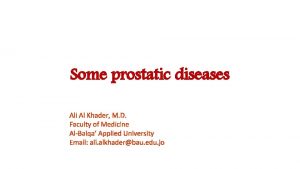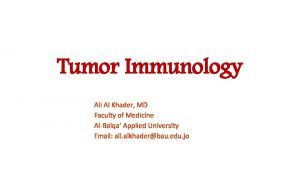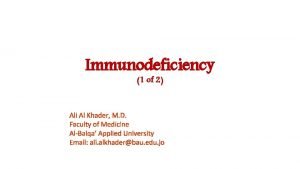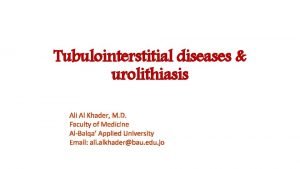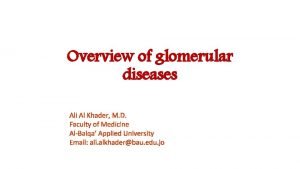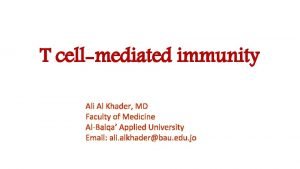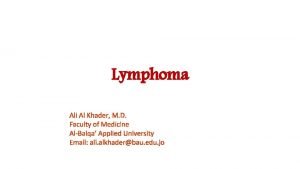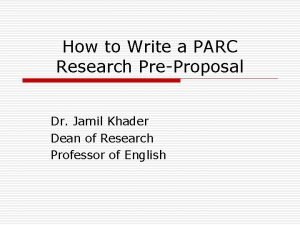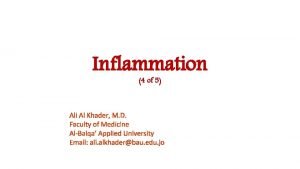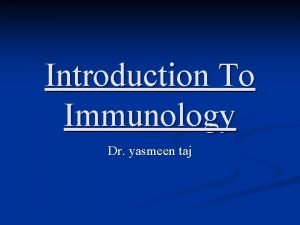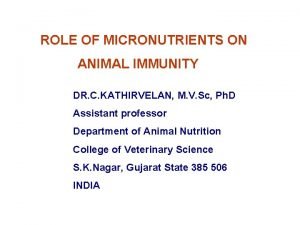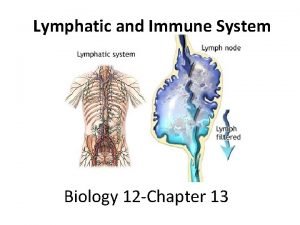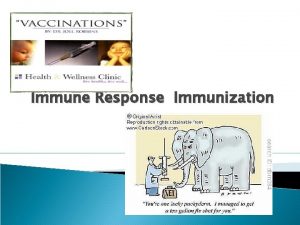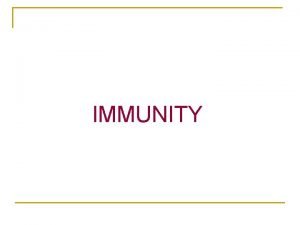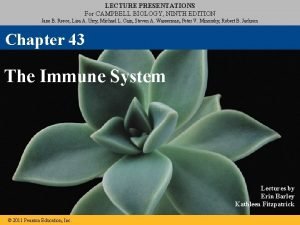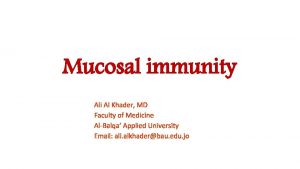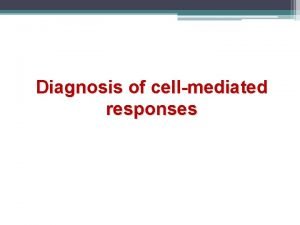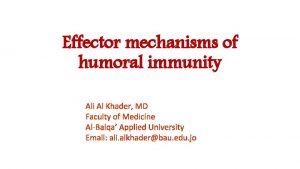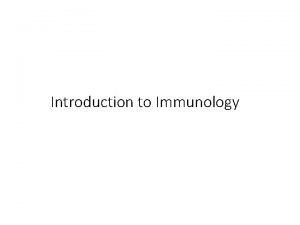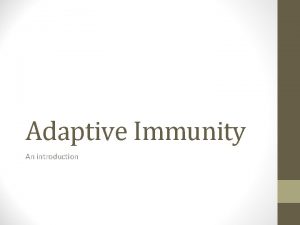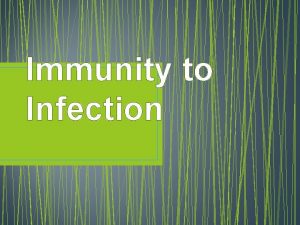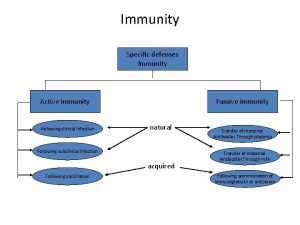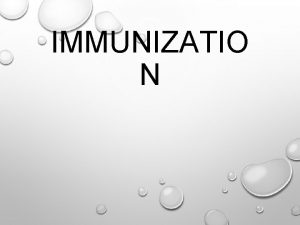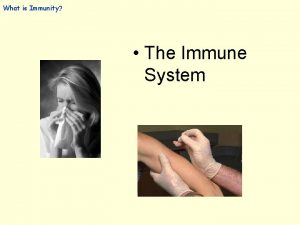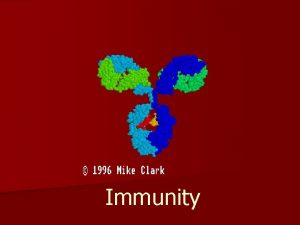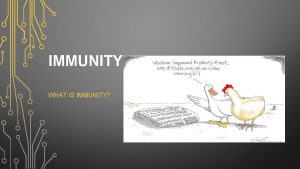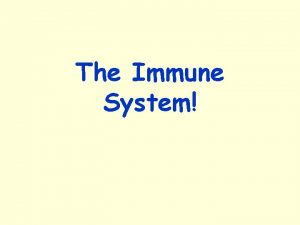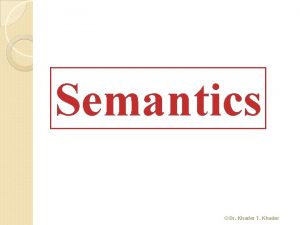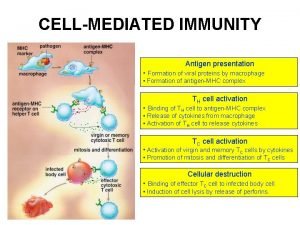T cellmediated immunity Ali Al Khader MD Faculty



















- Slides: 19

T cell-mediated immunity Ali Al Khader, MD Faculty of Medicine Al-Balqa’ Applied University Email: ali. alkhader@bau. edu. jo

Overview • For microbes within phagosomes in phagocytes…. CD 4+ T lymphocytes (TH 1) Activate phagocyte…by cytokines …studies on Listeria monocytogenes • For microbes infecting and replicating in the cytoplasm of different cell types…CD 8+ …also for microbes in phagocytes that escaped from the phagosome into the cytosol

Overview, cont’d • T cell-dependent macrophage activation and inflammation may damage normal tissues… = delayed type hypersensitivity • For helminths…TH 2 cells -stimulate secretion of Ig. E -activate eosinophils & mast cells

IFNgamma & IL-12 CD 4+ TH 1 Naïve CD 4+ IL-4 TH 2 TH 1 Of its functions: further differentiation of TH 1 and inhibition of TH 2 proliferation Transcription factors that work here are: STAT 1, T-bet, & STAT 4 Of its functions: promotion of TH 2 differentiation TH 2 IFN-gamma IL-4, IL-5, IL-13, IL-10 CXCR 3, CCR 5 CCR 4, CCR 8, CXCR 4 Ligands for E- & P-selectin Classically activate macrophages Alternatively activate macrophages Of its functions: inhibition of TH 1 development

2 major pathways of macrophage activation: From T lymphocytes and others And foreign materials Also induces macrophages to become multinucleated giant cells From -T lymphocytes -mast cells -eosinophils…etc. The major role of alternatively activated macrophages Robbins basic pathology 9 th edition…modified

Differentiation of CD 4+ into TH 1…due to: • Intracellular microbes in phagocytes (macrophages and dendritic cells) or when microbes bind to Toll-like receptors on these cells …secretion of IL-12, IL-18 and IFN-gamma • Also stimulated NK cells secrete IFN-gamma…this stimulates macrophage to secrete IL-12 Mutation will cause: …. . CD 40 ligand (CD 40 L) on T cell binding to CD 40 on APC stimulates cytokine production from APCs

Effector functions of TH 1 cells • Secretion of IFN-gamma… phagocyte killing of microbe …secretion of antibodies from B cells (Ig. G for opsonization and complement-fixation) • Secretion of lymphotoxin (LT) & TNF…activation of neutrophils/inflammation • Excessive activation of TH 1…some autoimmune diseases & granulomatous inflammations…see next slide Note: The migration of effector T cells from the circulation to peripheral sites of infection is largely independent of antigen, but cells that recognize antigens in tissue are preferentially retained there

Delayed type hypersensitivity reactions • As a collateral damage in response to microbes or pathologic from the beginning (autoimmune disease) • Sensitization and challenge? ? ? • PPD test? ? ?

TH 2 differentiation • In response to helminths and allergens • Interplay of IL-4, TCR signals and transcription factors (GATA-3 & STAT 6) • Little role of innate cells here

TH 2 responses • IL-4 stimulates production of helminth-specific Ig. E…coat the helminth Mast cells have Fc receptors for Ig. E • IL-5 stimulates eosinophils Secrete major basic protein and major cationic protein…destroy helminths Release of vasoactive amines, eicosanoids & cytokines • Macrophages activated here induce formation of granulomas in chronic parasitic infection and tissue remodeling in allergy

TH 2 responses, cont’d • IL-13 stimulates mucus production • IL-4 stimulates peristalsis in GIT

TH 17 • Do not produce IFN-gamma or IL-4 • Secrete IL-17…recruitment of neutrophils and monocytes • Their differentiation is induced by: -antigen -TGF-beta…a stimulator of regulatory T cells -IL-6 -IL-1 -IL-23

CD 8+ (CTL: cytotoxic T lymphocytes) • CTL-mediated killing: -Antigen recognition -Activation of CTLs -Delivery of the “lethal hit” -Release of the CTLs

CD 8+…antigen recognition • TCR + co-receptor (CD 8) + adhesion molecules (e. g. , LFA-1) ICAM-1 is its ligand • The signals from dendritic cells that induced CTLs differentiation are not required for activating killing • CD 8+ also expresses KIR and receptors for MICA and MICB

CD 8+…the lethal hit they release their contents by exocytosis into the synapse between the 2 cells In cytoplasmic granules (= secretory lysosomes) After killing signal, the target cell dies even if the CD 8+ detaches

CD 8+…granule contents • Granzymes A, B and C …serine proteases Cathepsin B: protects CTLs by degrading perforins if they are in contact with CTL membrane Caspase-independent pathways Activates caspase 3 and Bid • Perforin…homologous to C 9 • Serglycan…a sulphated proteoglycan • Granulysin…alter permeability of target membranes

CD 8+…surface molecules • Fas ligand (Fas. L) …important also in killing activity of CD 4+!

Memory T cells • May be derived from CD 4, CD 8, TH 1 or TH 2 • Central VS effector memory T cells? ? • Maintenance of memory cells: …IL-7 for CD 4+ and CD 8+ …IL-15 for CD 8+

Thank You
 Ali al khader
Ali al khader Ali al khader
Ali al khader Ali al khader
Ali al khader Ali al khader
Ali al khader Ali al khader
Ali al khader Microbes
Microbes Ali al khader
Ali al khader Difference between acquired immunity and innate immunity
Difference between acquired immunity and innate immunity Jamil khader
Jamil khader Jamil khader
Jamil khader Al khader proteins
Al khader proteins Define immunity
Define immunity Conclusion of immunity
Conclusion of immunity Second line of defense immune system
Second line of defense immune system Immunity
Immunity Chapter 13 lymphatic system and immunity
Chapter 13 lymphatic system and immunity Naturally acquired passive immunity definition
Naturally acquired passive immunity definition Local immunity ppt
Local immunity ppt Innate immunity first line of defense
Innate immunity first line of defense Opsonization
Opsonization
